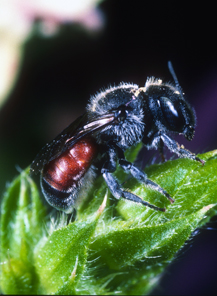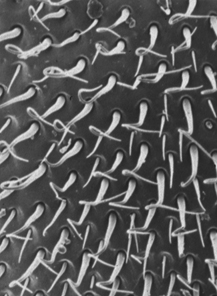Subgenus Erythrosmia
The subgenus Erythrosmia Schmiedeknecht is confined to the Palaearctic region. It contains 4 described species.
Female of Osmia (Erythrosmia) andrenoides (left); the females of this species possess twisted bristles on clypeus and frons (right), which are used to remove pollen from the anthers of nototribic flowers of Lamiaceae and Antirrhineae. Fotos A. Müller.
Species accounts
Osmia (Erythrosmia) andrenoides Spinola, 1808
1808 Osmia andrenoides Spinola, Insectorum Liguriae, vol. 2, p. 61. Type material: Syntypes m(m), f(f), “habitat prope Genuam, in loco dicto Marassi” [Italy]. Type species of Erythrosmia Schmiedeknecht.- Combination Pseudosmia andrenoides (Spinola) in Radoszkowski (1874: 158). Combination Osmia (Osmia) andrenoides Spinola in Friese (1911b: 108). Combination Anthocopa (Erythrosmia) andrenoides (Spinola) in Tkalcu (1974b: 328).
Distribution-Europe: A, AL, AZ, B, BG, CH, CZ, D, E, E(Ba), F, GE, GR, GR(Aegean Islands, Cr), H, HR, I, I(Sa, Si), MK, P, PL, RO, RUS(SR), SCG, SK, SLO, UA, UA(Crimea). Northern Asia: TM. Southwestern Asia: CY, IL, IRQ, JOR, RL, SYR, TR.
Identification-Keys, Descriptions: Alfken (1914: 200); Amiet et al. (2004); Banaszak and Romasenko (2001); Benoist (1931); Ducke (1900); Ferton (1905: 5657); Medvedeva (1978); Móczár (1958); Müller (2020); Popov (1954: 444); Radoszkowski (1874c: 158); Scheuchl (1996); Schmiedeknecht (1885-1886).
Nesting biology-Nesting site: Preexisting cavities: empty snail shells of small to medium size (e.g. Cepaea, Cernuella, Helix, Pomatias, Theba, Xerolenta, Zebrina), which are hidden at (semi-)shaded places under prominences of stones and rocks or under large flat stones, which might explain the species’ distinct preference for rocky and stony habitats. The nests contain 1–3 brood cells. In sealed nests, the closed shell orifice faces upwards or to the side, suggesting that the nest shells are not moved at the end of the nesting cycle. Nesting material: The brood cells are separated from each other by one-layered partitions constructed from leaf pulp, e.g. of Helianthemum (Cistaceae) or Potentilla (Rosaceae) The nests are not sealed against their rear end with a basal wall. After completion of the outermost brood cell, the shells are barricaded towards the nest opening with densely packed earth crumbs, small stones and other particles followed by two adjacent walls of leaf pulp at the shell opening, which enclose a narrow interspace usually filled with few earth crumbs or small stones. The females do not cover the surface of the nest shells with patches of leaf pulp after nest site selection. Life cycle: The species overwinters as a fully developed imago in a self-spun cocoon within the brood cell. Phenological data, which cover an extended period from early spring to early fall at some localities, suggest that the species has two generations per year at more southern latitudes, such as southern Europe or mediterranean Turkey. Brood parasites: The chrysidid wasps Chrysis analis Spinola, Chrysura cuprea (Rossi) and Chrysura dichroa (Dahlbom) develop as parasitoids in the nests of O. andrenoides. (Banaszak and Romasenko, 2001; Benoist, 1931; Berland & Bernard 1938; Ducke, 1900; Ferton, 1894, 1908; Müller & Richter, 2019; Popov, 1954; Rosa et al., 2017; Stoeckhert, 1933; Westrich, 1989; G. Le Goff, personal observation)
Flower preferences: Polylectic with affinity for nototribic flowers of both Lamiaceae (e.g. Acinos, Ajuga, Ballota, Prasium, Satureja, Stachys, Teucrium) and Antirrhineae (e.g. Linaria) as well as for Fabaceae (e.g. Lotus, Onobrychis, Trifolium, Genisteae). Additional pollen sources include Crassulaceae, Cistaceae (e.g. Cistus, Helianthemum), Brassicaceae, Echium (Boraginaceae), Campanulaceae, Plantago (Plantaginaceae) and Asteraceae (Cichorioideae). The females are equipped with a specialized pilosity on clypeus and frons composed of apically twisted bristles, which are used to comb pollen from the raised anthers of nototribic flowers. (Müller, 1996b, 2020; Müller et al., 1997)
Osmia (Erythrosmia) erythrogastra Ferton, 1905
1905 Osmia erythrogastra Ferton, Annales de la Société Entomologique de France, 74: 56. Type material: Lectotype m, by designation of Le Divelec (2024: 176) “Bonifacio” [France: Corsica], MNHN (Paris); paralectotypes ff, m.-Combination Anthocopa (Erythrosmia) erythrogastra (Ferton) in Zanden (1988b: 119).
Distribution-Europe: BG, F, F(Co), GR, GR(Aegean Islands), I, I(Sa, Si), SCG. Southwestern Asia: CY, IL, JOR, SYR, TR.
Identification-Keys, Descriptions: Alfken (1914: 200); Benoist (1931); Müller (2020).
Nesting biology: Unknown.
Flower preferences: Polylectic with affinity for nototribic flowers of both Lamiaceae (e.g. Lamium, Stachys) and Antirrhineae as well as for Fabaceae (e.g. Lotus, Trifolium). Additional pollen sources include Echium (Boraginaceae), Asteraceae (Cichorioideae, Carduoideae) and Brassicaceae. The females are equipped with a specialized pilosity on clypeus and frons composed of apically twisted bristles, which are used to comb pollen from the raised anthers of nototribic flowers. (Müller, 2020)
Osmia (Erythrosmia) relicta (Popov, 1954)
1954 Anthocopa (Erythrosmia) relicta Popov, Zoologicheskiy Zhurnal (Moscow), 33: 448. Type material: Syntypes ff, “River Tuyuk, Kyrgyz Ridge” [Kyrgyzstan], ZIN (St. Petersburg).
Distribution-Northern Asia: KS, KZ, TJ.
Identification-Keys, Descriptions: Müller (2020).
Nesting biology: Unknown.
Flower preferences: Polylectic with affinity for nototribic flowers of Lamiaceae and Antirrhineae. Additional pollen sources include monocotyledons probably of the genus Eremurus (Asphodelaceae), Potentilla (Rosaceae), Fabaceae, Crassulaceae and Echium (Boraginaceae). The females are equipped with a specialized pilosity on clypeus and frons composed of apically twisted bristles, which are used to comb pollen from the raised anthers of nototribic flowers. (Müller, 2020)
Osmia (Erythrosmia) sparsipuncta Alfken, 1914
1914 Osmia sparsipuncta Alfken, Mémoires de la Société Entomologique Belgique, 22: 200. Type material: Holotype f, “Alger, Maison Carrée” [Algeria], ZMHB (Berlin); paratypes mm, ff.-Combination Anthocopa (Erythrosmia) sparsipuncta (Alfken) in Zanden (1988b: 119).
Distribution-Northern Africa: DZ, MA, TN.
Identification-Keys, Descriptions: Müller (2020).
Nesting biology: Unknown.
Flower preferences: Polylectic with affinity for nototribic flowers of both Lamiaceae (e.g. Stachys) and Antirrhineae as well as for Fabaceae (e.g. Lotus, Onobrychis). Additional pollen sources include Echium (Boraginaceae) and Brassicaceae. The females are equipped with a specialized pilosity on clypeus and frons composed of apically twisted bristles, which are used to comb pollen from the raised anthers of nototribic flowers. (Müller, 2020)

